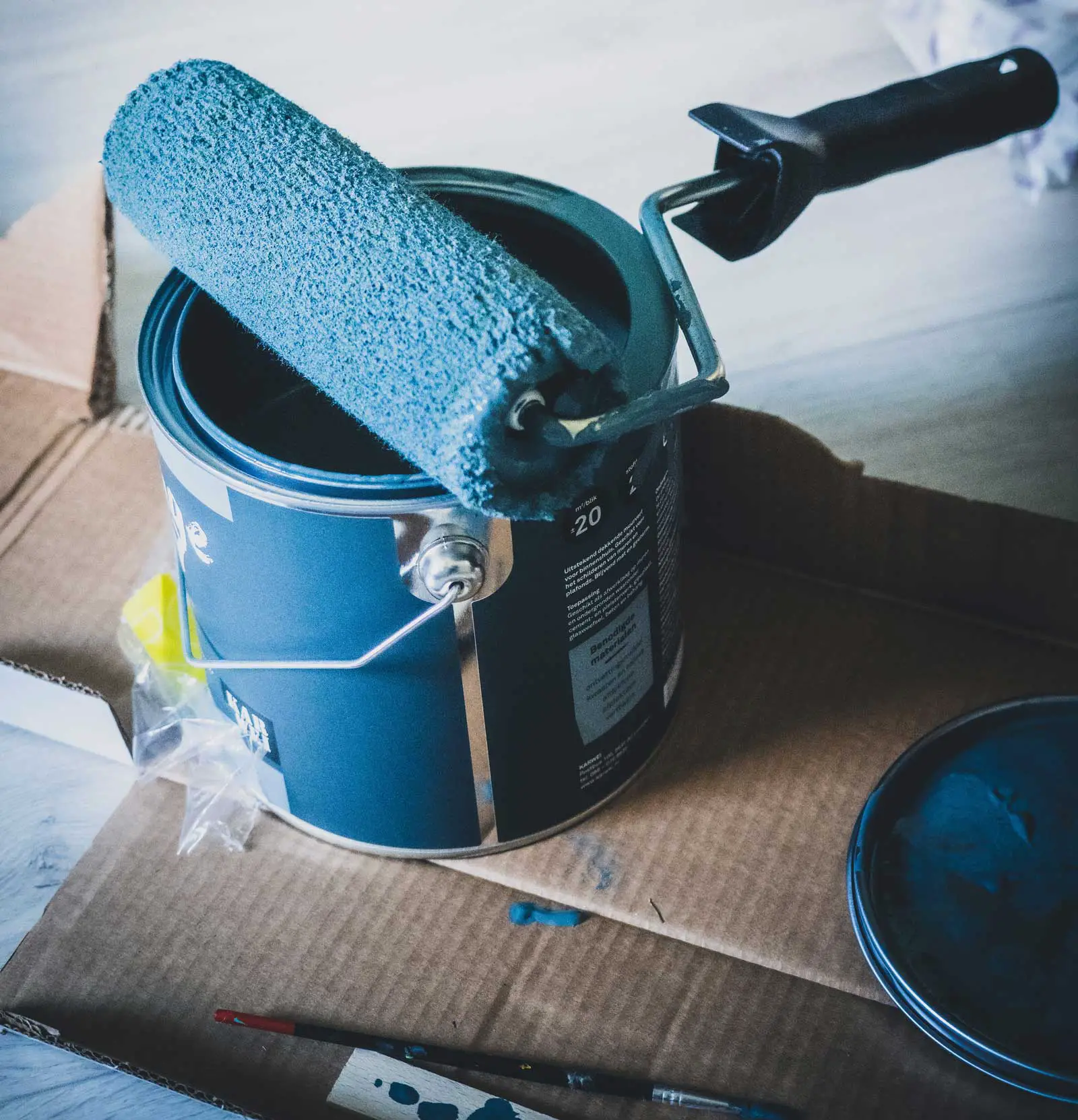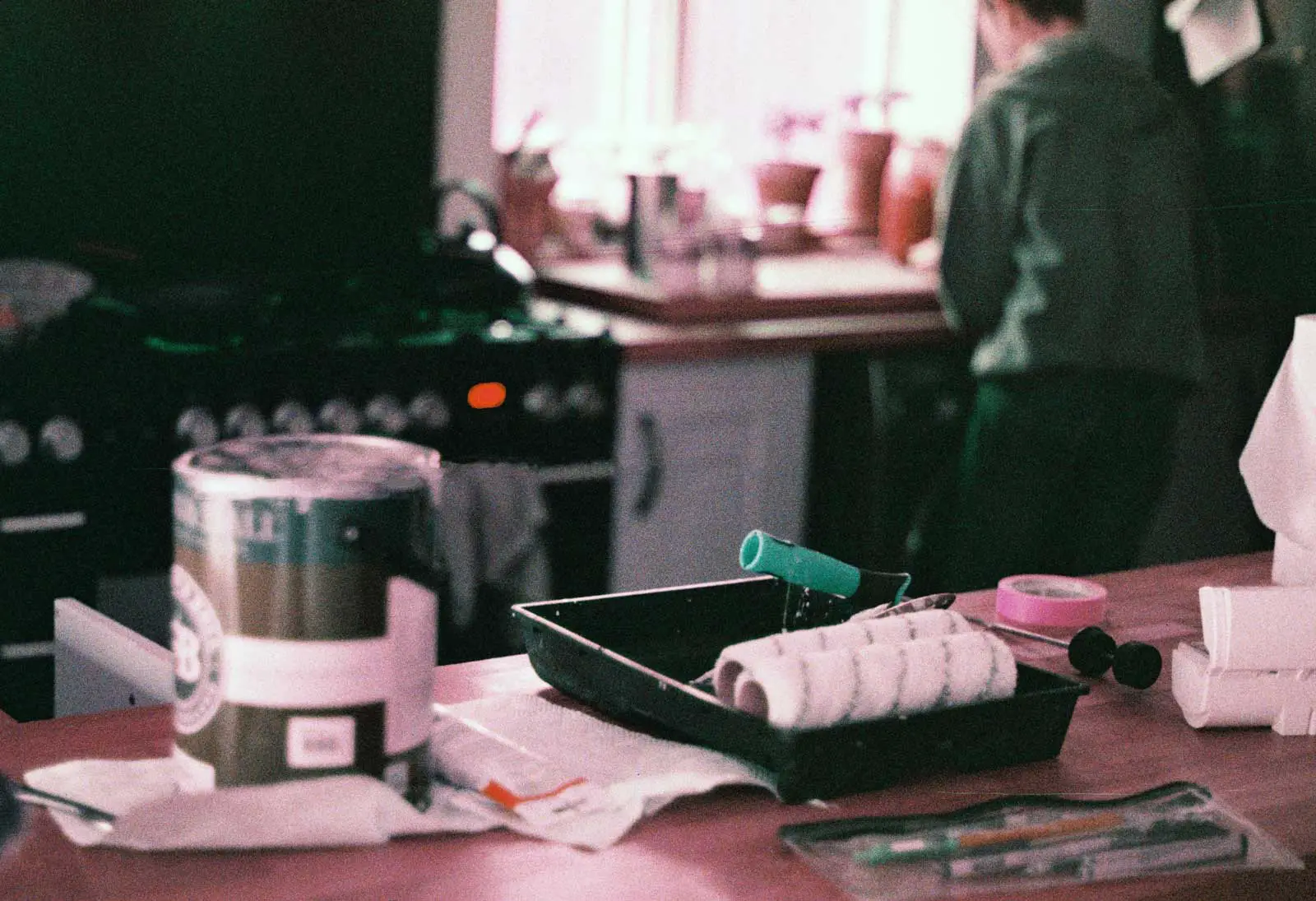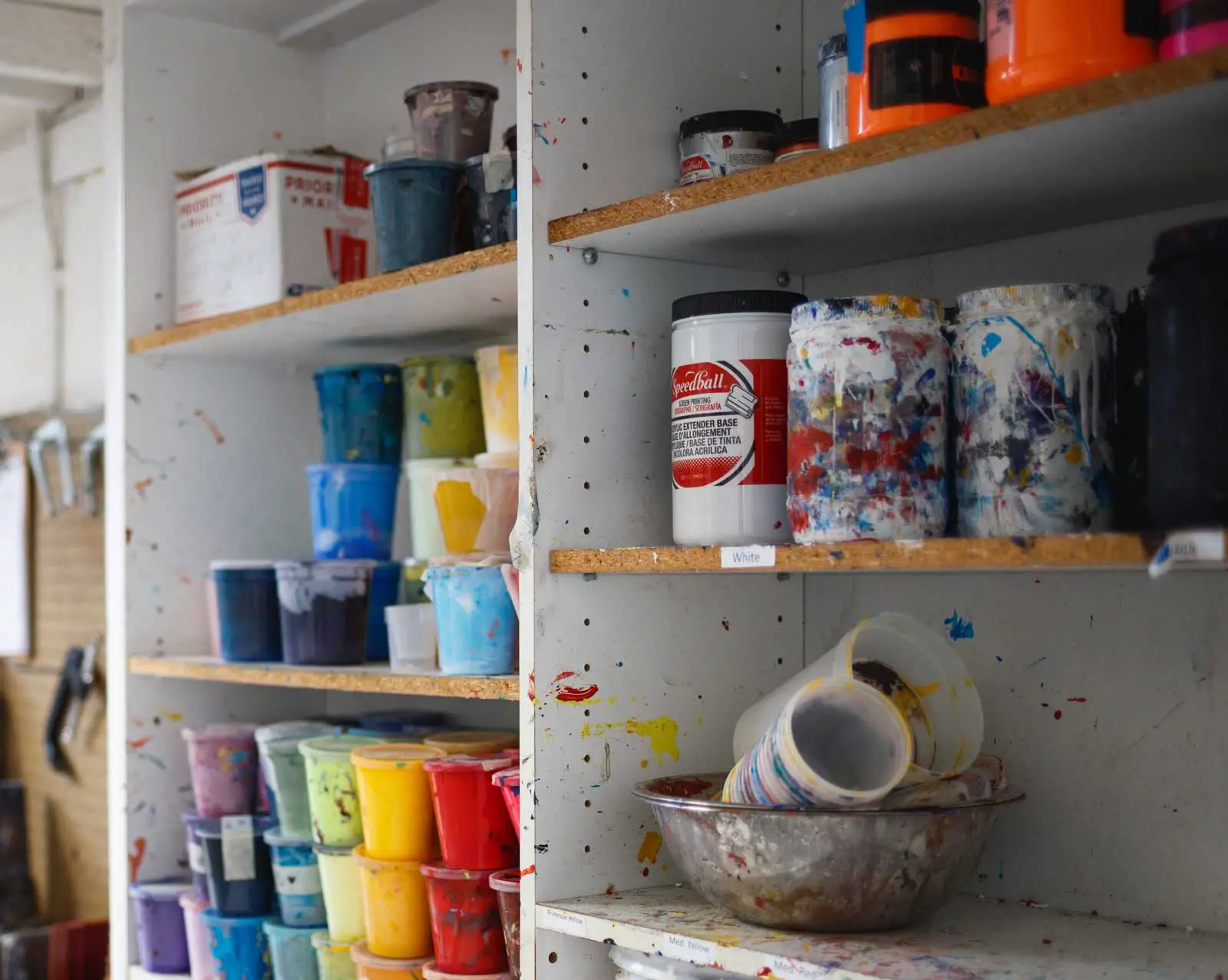How much does a gallon of paint weigh?
Think about it: you’re going to roll all that paint on to a wall, and so the weight will be transferred to that wall. Or to your shudders. Or your exterior walls.
But if you’re thinking about storing left-over paint, putting it on shelving in your garage, upstairs, or somewhere else, it’s a fair question to ask.
So how much does a gallon of paint weigh?
A gallon of paint can weigh anywhere between 10-15 pounds, depending on the type of paint being used. For example, oil-based paints typically weigh between 11-12 pounds per gallon while water-based paints usually weigh between 13-14 pounds per gallon. Enamel paint and acrylic polymer emulsions both have an average weight of 11-12 pounds per gallon. It’s important to note that the weight of a gallon of paint can also vary depending on the solids percentage and ingredients used by the manufacturer.
Of course, which paint is right for your project mostly depends on the coverage, durability, and cost, but understanding how much a gallon of paint weighs can also be important too.
In this article I’ll answer the question: How much does a gallon of paint weigh? I’ll also answer the next question, why does it matter?
With this information, you can be sure your next trip to the hardware store is painless and successful!
By the way – before we get too far along here, if you want to connect with other homeowners and builders and get more great ideas for your home to make your space the best join my free private Facebook group, Remodel Reality here.
 Weight of a Gallon of Paint
Weight of a Gallon of Paint
Understanding how much a gallon of paint weighs is really important when it comes to safely transporting and storing it. The weight of a gallon of paint depends on the type of paint and how many solids are in it. A gallon can either be measured in imperial gallons, which is 4.546 liters, or US gallons, also called dry gallons, which is 3.785 liters. This difference in volume is pretty significant because the imperial gallon is larger than the dry gallon.
The weight of a gallon of paint varies depending on its type — oil-based paints typically weigh between seven and eight pounds while water-based paints usually weigh between eight and nine pounds per gallon. Typically, enamel paint or acrylic polymer emulsions both have an average of eight to nine pounds per gallon.
If you need to convert those measurements from gallons to pounds conversion, use the PPG (pounds per gallon) formula that divides the weight of the paint by its volume in gallons. For instance if one gallon weighs 8 pounds then its PPG will be 8 as well.
You can use this formula to determine how much paint you need for any given project based off the number of gallons being used for that project plus calculate for transportation and storage needs accurately without too much difficulty or hassle. As you can see, it’s vitally important that you understand exactly how much your gallon of paint weighs so that you can plan safely for transportation and storage needs plus get an accurate estimate for the amount of materials needed for any given project.
| Type of Paint | Weight of One Gallon of Paint | Weight of Five Gallon Bucket of Paint |
|---|---|---|
| Oil-Based Paint | 11-12 pounds | 55-60 pounds |
| Water-Based Paint | 12-13 pounds | 60-65 pounds |
| Enamel Paint | 12-13 pounds | 60-65 pounds |
| Latex Paint | 12-13 pounds | 60-65 pounds |
| Acrylic Polymer Emulsion | 12-13 pounds | 60-65 pounds |
Note: The weights provided above are approximate values and can vary depending on the specific paint brand and formulation.
 Factors that Affect the Weight of a Gallon of Paint
Factors that Affect the Weight of a Gallon of Paint
There are various factors that can affect the weight of a gallon of paint. The type of paint used is one such factor (we’ll talk more about that in just a minute below).
Generally speaking, oil-based paints tend to be heavier than water-based paints because they contain a higher percentage of solids. Solids are non-volatile components in paint which contribute to the overall weight. Higher solid percentages in the paint typically make it heavier but also more durable and longer lasting, making them ideal for high traffic areas.
The ingredients used by the manufacturer can also play a role in the weight of the paint. Cheaper ingredients, such as fillers, might be attractive from a cost perspective, but they have a lightening effect on paint weight and may lower its quality.
Some manufacturers may use hazardous materials such as lead or VOCs in their paint formulas; these additives add extra weight to the formula but are not generally considered environmentally friendly or safe for the user. Some companies now use synthetic solvents and safer ingredients which do not harm or pollute the environment and which have less drastic impacts on the resulting paint’s weight than before.
It’s important to research each type of paint when deciding which one to purchase for your project as this will determine how much space it takes up when it comes time for transportation and storage for any leftovers. Additionally, look out for manufacturers who use high quality ingredients and prioritize quality over quantity; this will result in a higher quality finish with a longer life expectancy despite slightly increased overall weight on a per-gallon basis.
 Painting Projects and Gallon Size
Painting Projects and Gallon Size
The amount of paint needed for a given project depends on the surface area to be covered. Repainting a typical room may require just one gallon while painting an entire house would require many more gallons. The weight of the paint container is another thing to keep in mind when choosing which size will work best for you since heavier containers can be harder to transport and store away when not being used.
So, before starting any painting projects, take into account both the approximate surface area coverage of one gallon of paint and its corresponding weight so you can plan accordingly and have everything you need right where it needs to be when you need it. Taking these factors into consideration will help make sure your painting projects are successful every time!
Area Covered by a Gallon of Paint
So if a gallon of paint weighs roughly 11-12 pounds, how much area will that actually cover?
Generally speaking, one gallon can cover an area of 200 to 400 square feet.
Oil-based paints are commonly used for exterior surfaces like doors, trims and shutters. This type of paint tends to provide good coverage with up to 400 square feet per gallon, but may require multiple coats for full coverage and more time to dry than other kinds.
Water-based or latex paints are great options for both interior and exterior applications. This kind is easy to apply, dries quickly and provides up to 350-400 square feet per gallon. It also has less odor and is easier to clean up than oil-based paint.
For metal, wood or hard surfaces, enamel paints are a popular choice as they have high durability as well as an attractive glossy finish. One gallon typically covers around 200-250 square feet but requires a longer drying time and tougher cleanup job than water-based paint does.
Finally, acrylic polymer emulsion is a water-based option that excels in surface protection as well durability and versatility – making it suitable for both interior and exterior jobs alike. This type will give you 350-400 square feet per gallon while drying fast, emitting low odours and being easy to clean up afterwards.
| Type of Paint | Coverage per Gallon | Area Covered per 5-Gallon Bucket |
|---|---|---|
| Oil-Based Paint | 300-400 sq. ft. | 1,500-2,000 sq. ft. |
| Water-Based Paint | 350-400 sq. ft. | 1,750-2,000 sq. ft. |
| Enamel Paint | 200-250 sq. ft. | 1,000-1,250 sq. ft. |
| Latex Paint | 350-400 sq. ft. | 1,750-2,000 sq. ft. |
| Acrylic Polymer Emulsion | 350-400 sq. ft. | 1,750-2,000 sq. ft. |
Note: The coverage per gallon provided above is an approximate value and can vary depending on the specific paint brand, surface porosity, and the thickness of the application.
Different Types Of Paint
With so many different types of paint available on the market, it can be difficult to decide which one to use. Let’s take a look at some of the types of paint and their distinct properties.
Oil-based paint, also known as alkyd paint, is made with a solvent base and an alkyd resin. This type of paint has a longer drying time (24 hours) but produces a smooth and glossy finish that makes it great for metal surfaces or woodwork. It is also more durable and long-lasting compared to other types.
Water-based paint, also called latex paint, is made with water and a resin binder. It is quick to dry (4 hours), eco-friendly, and easy to clean up – making it perfect for indoor use on plaster or drywall since it does not emit harmful fumes or contain volatile organic compounds (VOCs).
Enamel paint is another oil-based alternative that offers excellent durability and a glossy finish that makes metal surfaces, woodwork, and appliances pop! Enamel paint dries quickly (around 4 hours) without sacrificing its smooth surface.
The last type we’ll cover is acrylic polymer emulsion – this kind uses acrylic resin as its binder. This makes it resistant to fading and chalking while still being able to produce excellent results in just two hours -perfect for exterior painting projects!
Each type of these paints come with their own unique properties that make them suitable for different kinds of surfaces and finishes -all you need to do now is consider the desired finish by choosing the right type of paint for your project.
| Type of Paint | Used for |
|---|---|
| Oil-based paint | Best for metal surfaces and woodwork due to its long-lasting and durable finish. The glossy finish produced by oil-based paints is perfect for surfaces that require a polished appearance. It’s ideal for areas exposed to wear and tear such as door trims and shutters. |
| Water-based paint (Latex paint) | Suitable for indoor use on plaster or drywall. It’s quick to dry, eco-friendly and easy to clean up. It doesn’t emit harmful fumes or contain volatile organic compounds (VOCs), making it a safer option. |
| Enamel paint | Another oil-based alternative that offers excellent durability and a glossy finish, making it perfect for metal surfaces, woodwork, and appliances. It’s quick to dry, taking about 4 hours, and produces a smooth surface. |
| Acrylic polymer emulsion | This kind uses acrylic resin as its binder, making it resistant to fading and chalking while still being able to produce excellent results in just two hours. It’s ideal for exterior painting projects, providing good durability and long-lasting results. |
Next Steps
Want to join others who are creating the most amazing home redesigns & renovations and get more tips, tricks and hacks on how to make your home the best it can be?
Join my brand new free private Facebook group, Remodel Reality to connect with other people like you to make your space the best!






